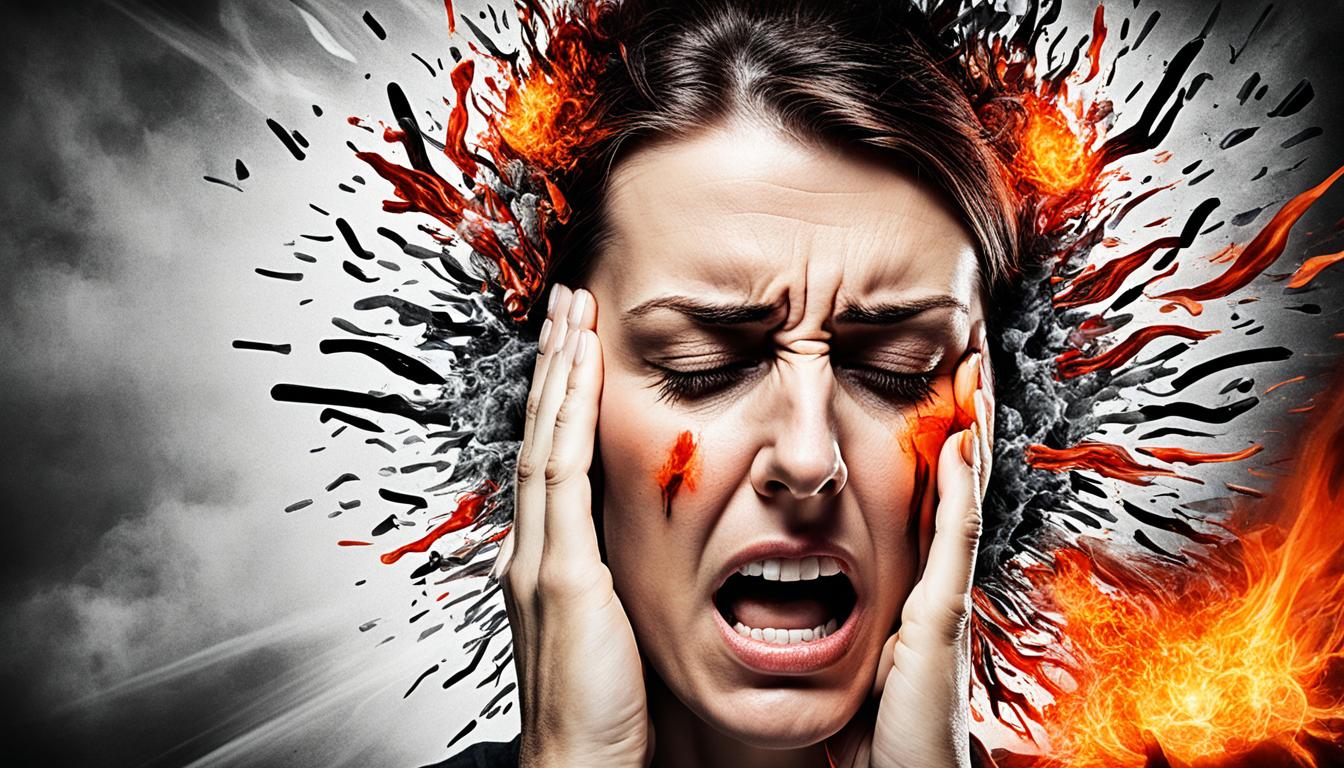Cluster headaches cause intense pain on one side of the head or around an eye. They come in groups, lasting weeks to months. This is followed by periods without pain that can last for months or years.
The cause of cluster headaches is not clear. They might be linked to issues with blood vessels, nerves, and brain chemicals. The trigeminal nerve, which handles sensations from the face, is also part of the problem.
These headaches are very painful and can make the eyelids swell or droop. Eyes water, the nose can be stuffy, and one eye’s pupil might get smaller. There could be sweat on the forehead and face too. People with these headaches find it hard to be around bright light or loud sounds.
Cluster headaches are not common, affecting fewer than 1% of people. They happen more often in men than women.
Key Takeaways:
- Cluster headaches cause intense, one-sided head or eye pain.
- They come in cycles and can last for weeks or months at a time.
- The cause is not fully understood; however, issues with blood vessels, nerves, and brain chemicals are thought to be involved.
- The trigeminal nerve, responsible for facial sensations, is linked to cluster headache attacks.
- Less than 1% of the population experience cluster headaches, and they are more common in men.
Diagnosis and Treatment of Cluster Headaches
Diagnosis is very important for identifying and treating cluster headaches. It needs a detailed look by a neurologist or headache expert. They will study your history, symptoms, do a physical check, and maybe even use imaging tests like MRI or CT scans.
While there’s no cure for cluster headaches, treatments can help with the pain and how often they happen. Quick treatments include breathing pure oxygen and using certain medicines like sumatriptan or octreotide. These medicines tighten blood vessels, easing the pain. Sometimes, local anesthetics can be used for fast relief too.
To prevent or lessen the headaches, there are medications like verapamil or galcanezumab. They’re aimed at stopping new headaches from coming. There’s also stem cell therapy, which is showing good results by helping the body repair and reduce swelling. For those that find usual treatments don’t work, surgery or nerve stimulation might be options.
Oxygen Therapy
Oxygen therapy is both safe and effective for cluster headaches. Breathing pure oxygen from a mask during an attack helps a lot. It makes blood vessels smaller and lessens the pain. This treatment is easy on the body and has little side effects. People like it for stopping headaches and also for keeping new ones away.
Medications for Cluster Headaches
There are many medicines used to deal with cluster headache symptoms. Sumatriptan, in forms like nasal sprays or tablets, quickly helps with pain. Verapamil is a medicine used every day to prevent and make less severe the headaches. It works by making the blood vessels in the brain relax, stopping the start of cluster headaches.
Comparison of Treatment Options for Cluster Headaches
| Treatment Option | Method | Effectiveness | Potential Side Effects |
|---|---|---|---|
| Oxygen Therapy | Inhaling pure oxygen | Highly effective for acute relief | Minimal side effects |
| Sumatriptan | Injections, nasal sprays, tablets | Fast relief from pain | May cause transient side effects |
| Verapamil | Oral medication | Prevents frequency and severity of attacks | Potential cardiovascular side effects |
| Stem Cell Therapy | Regenerative treatment using stem cells | Potentially effective in reducing inflammation and promoting tissue repair | Still in experimental stages; potential risks and long-term effects under investigation |
Living with Cluster Headaches and Coping Strategies
Living with cluster headaches can really affect how you live, work, and connect with others. But, there are ways to help manage these headaches. This involves changing your lifestyle and finding coping strategies.
Keeping a regular sleep routine and steering clear of alcohol is key to avoiding triggers. Some people find relief through alternative medicine. Melatonin and capsaicin have helped a few, but it’s important to talk to a doctor first.
Getting emotional and mental support is also crucial when facing these headaches. You can talk with a therapist or join a support group for people dealing with headaches. Writing in a headache diary helps to spot trends and triggers.
Discuss your worries with a healthcare provider if you’re living with cluster headaches. They can help create a treatment plan that’s just for you. By making some lifestyle changes, trying out different treatments, and finding support, dealing with these headaches can become a bit easier.

